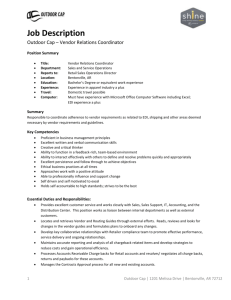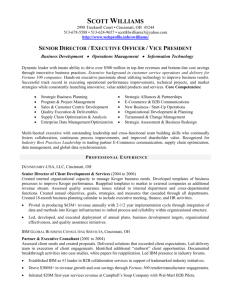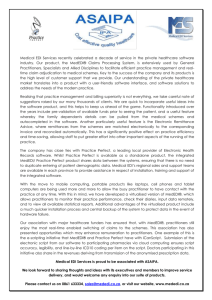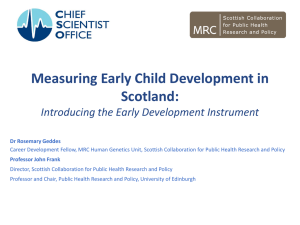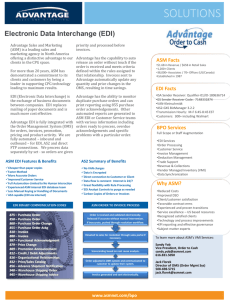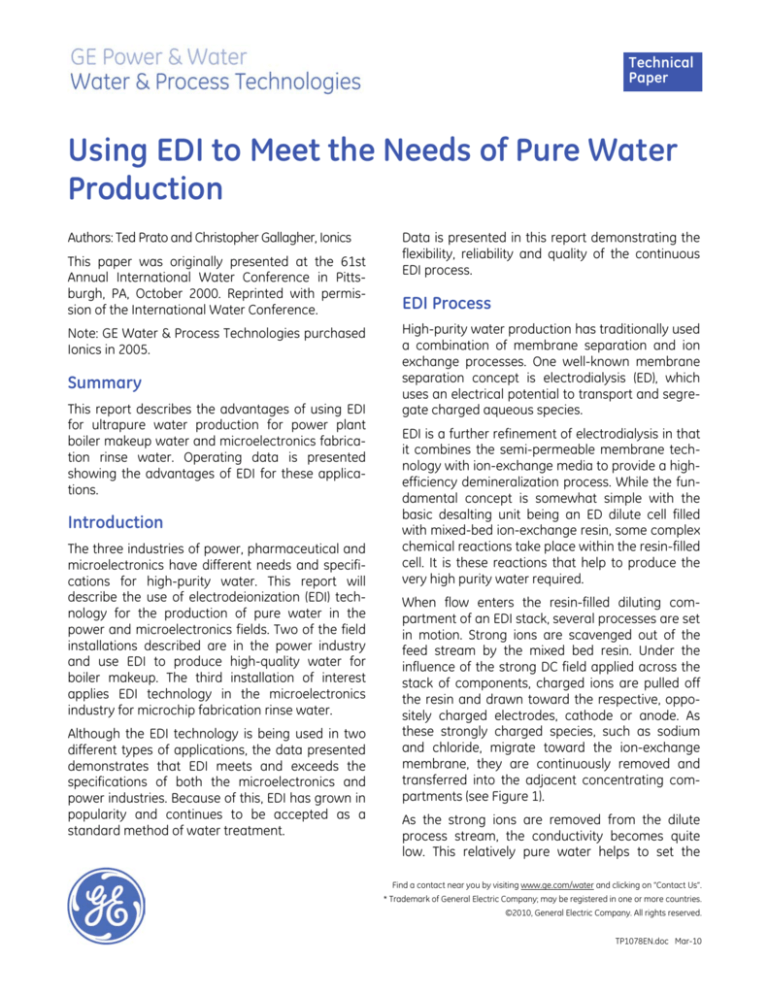
Technical
Paper
Using EDI to Meet the Needs of Pure Water
Production
Authors: Ted Prato and Christopher Gallagher, Ionics
This paper was originally presented at the 61st
Annual International Water Conference in Pittsburgh, PA, October 2000. Reprinted with permission of the International Water Conference.
Note: GE Water & Process Technologies purchased
Ionics in 2005.
Summary
This report describes the advantages of using EDI
for ultrapure water production for power plant
boiler makeup water and microelectronics fabrication rinse water. Operating data is presented
showing the advantages of EDI for these applications.
Introduction
The three industries of power, pharmaceutical and
microelectronics have different needs and specifications for high-purity water. This report will
describe the use of electrodeionization (EDI) technology for the production of pure water in the
power and microelectronics fields. Two of the field
installations described are in the power industry
and use EDI to produce high-quality water for
boiler makeup. The third installation of interest
applies EDI technology in the microelectronics
industry for microchip fabrication rinse water.
Although the EDI technology is being used in two
different types of applications, the data presented
demonstrates that EDI meets and exceeds the
specifications of both the microelectronics and
power industries. Because of this, EDI has grown in
popularity and continues to be accepted as a
standard method of water treatment.
Data is presented in this report demonstrating the
flexibility, reliability and quality of the continuous
EDI process.
EDI Process
High-purity water production has traditionally used
a combination of membrane separation and ion
exchange processes. One well-known membrane
separation concept is electrodialysis (ED), which
uses an electrical potential to transport and segregate charged aqueous species.
EDI is a further refinement of electrodialysis in that
it combines the semi-permeable membrane technology with ion-exchange media to provide a highefficiency demineralization process. While the fundamental concept is somewhat simple with the
basic desalting unit being an ED dilute cell filled
with mixed-bed ion-exchange resin, some complex
chemical reactions take place within the resin-filled
cell. It is these reactions that help to produce the
very high purity water required.
When flow enters the resin-filled diluting compartment of an EDI stack, several processes are set
in motion. Strong ions are scavenged out of the
feed stream by the mixed bed resin. Under the
influence of the strong DC field applied across the
stack of components, charged ions are pulled off
the resin and drawn toward the respective, oppositely charged electrodes, cathode or anode. As
these strongly charged species, such as sodium
and chloride, migrate toward the ion-exchange
membrane, they are continuously removed and
transferred into the adjacent concentrating compartments (see Figure 1).
As the strong ions are removed from the dilute
process stream, the conductivity becomes quite
low. This relatively pure water helps to set the
Find a contact near you by visiting www.ge.com/water and clicking on “Contact Us”.
* Trademark of General Electric Company; may be registered in one or more countries.
©2010, General Electric Company. All rights reserved.
TP1078EN.doc Mar-10
stage for further chemical reactions. The electrical
potential splits water at the surface of the resin
beads, producing hydrogen and hydroxyl ions.
These act as continuous regenerating agents of
the ion-exchange resin. These regenerated resins,
in turn, act as micro-regions of high or low pH
permitting ionization of neutral or weakly ionized
aqueous species such as carbon dioxide or silica.
Once these species acquire a charge through this
ionization process, they become subject to the
influence of the strong DC field and are removed
from the diluting compartment through the ionexchange membranes (see Figure 2). The membranes used in EDI stacks are flat sheet, homogeneous, ion exchange membranes which help to
provide efficient ion transfer.
Figure 1: EDI Flow Schematic
osmosis (RO), electrodeionization (EDI) and ionexchange polishing resin (IE). Feed water for this
unit is well water. (Figure 3)
Figure 3: Power Plant 1: Train of Unit Operations
The multimedia filters are backwashed manually
based on pressure drop through the filter. Dual softeners are regenerated by salt on a volume
throughput basis. Cartridge filters are rated at five
micron, and the dual filter system enables cartridge filter replacement without having to shut
down the system, as is true with the other pretreatment operations. The RO system is a singlepass RO system composed of a 3:1 array with 6M
vessels (6 elements per vessel). The EDI system
contains two EDI stacks each with a 50 gpm (0.2
m3/h) capacity. The EDI is operated at 95% recovery.
This unit has operated continuously since late 1997
and has consistently produced in-spec, high purity
water for the power plant boiler makeup requirements. No chemical cleanings have been required
for the EDI or RO process streams during the 2,300
hours of operation.
Power Plant 2
Resin in hydrogen and hydroxide forms
Removal of weakly ionized compounds by ionization reactions
CO2 + OH-
HCO3 - pKa = 6.4
HCO3- + OH-
CO3 = pKa = 10.3
SiO2 + OH-
HSiO3 - pKa = 9.8
H3BO3 + OH-
B(OH)4 - pKa = 9.2
NH3 + H+
NH4 + pKa = 9.2
Figure 2: Ionization Reactions in EDI Diluting
Compartments
Description of Sites
Power Plant 1
This water treatment system supplies ultrapure
water to a small-scale, fossil fuel, municipal power
plant. Total treated water flow is just below 100
gallons per minute on a continuous basis for highpurity steam makeup water.
The plant is a land-based unit and includes the following train of water treatment unit operations:
multi-media filters (MMF), sodium zeolite softeners
(NaZe), followed by cartridge filters (CF), reverse
Page 2
This trailer-mounted build-own-operate (BOO)
ultrapure water treatment system has been supplying all of the ultrapure water requirements for a
nuclear power plant located in the southeastern
United States. The 120 gpm (0.5 m3/h) of
ultrapure water is used for steam generator
makeup water. Feed water comes from a surface
water source.
The triple membrane trailer (TMT) design is configured as ultrafiltration (UF), reverse osmosis, and
EDI. The capacity of this system is 360 gpm (1.4
m3/h). Downstream from the TMT is mixed bed ionexchange resin, deoxygenation via catalytic oxygen reduction system (CORS) as well as total
organic carbon (TOC) destruct systems.
This TMT is set to operate continuously in automatic mode. A customer start signal will enable
production of ultrapure water.
The EDI unit capacity is set 100 gpm (0.4 m3/h)
product. EDI performance, measured as product
resistivity, has remained consistently high. The
exception to this is a decline in product resistivity
TP1078EN
late in 1999. This was addressed by performing a
dilute stream clean-in-place (CIP). Full product
quality was recovered after the CIP. Among the
reasons for product quality decline include biofouling. This CIP will be discussed in more detail.
This set of four identical EDI units has operated
continuously since start-up and produced consistently high meg-ohm/cm product. Silica removal
has also remained very high. No chemical cleanings have been required in the EDI dilute process
stream. Other process streams have received low
pH flushes as a preventative maintenance measure.
Data Presentation and Discussion
Power Plant 1
Figure 4: Power Plant 2: Train of Unit Operations
Microchip Manufacturing Plant
The water treatment plant for this microchip
manufacturing plant has been online for approximately 18 months. The process train consists of
multimedia filters, cartridge filters, two-pass
reverse osmosis, electrodeionization, ion-exchange
polishing (IX) and TOC control. (Figure 5)Feed to this
system is from surface water sources. Ionexchange is normally used as a final polishing step.
Figure 5: Microchip Plant Water Treatment System
This EDI unit is composed of four separate skids
each with a product flow of 200 gallons per minute
for a total capacity of 800 gallons per minute.
Normally all four units are in operation due to high
plant demand.
Immediate pretreatment for the EDI units consists
of multimedia filters, followed by cartridge filters
and a large array of double-pass reverse osmosis.
When an EDI unit is ramped down for service or
other reason, one of four RO units also automatically switches off. Downstream from the EDI unit
are primary and secondary mixed-bed ion
exchange, TOC destruct and polishing ultrafiltration.
TP1078EN
This plant has performed consistently well since
initial startup. Figure 6 shows EDI product resistivity versus time. Operating hours total approximately 2,300 hours. EDI product resistivity begins
with an average of 13.5 megohm-cm, but it quickly
climbs to a long-term average of 15.5 megohmcm. Over the final thousand hours, product
quality continues to increase to the 16 to 18
megohm-cm range.
Figure 6: Power Plant 1:EDI Product Resitivity vs. Time
June 1998 - Present
This resistivity data shows periodic spikes, an artifact of the randomly chosen data points and the
variability in feed water quality. No RO cleanings
have been required. There have also been no EDI
process stream cleanings.
Figure 7 shows long-term silica rejection vs. time.
Silica reduction is shown to be consistently in the
99 percent range with hardly any deviation over
the entire operating life of the EDI unit. Silica feed
to the unit is typically 400 ppb with silica in the
product averaging a consistent 2-3 ppb. Table 1
shows EDI product quality.
Page 3
stack pressure drop also began to increase. To
stop the pressure increase and decline in product
quality, a dilute stream cleaning was initiated.
While a brine stream cleaning does not require
stopping high purity water production, a dilute
stream cleaning necessitates a complete shutdown of the EDI unit. The dilute stream process
cleaning completely recovered EDI product quality
and pressure drop to a current average of
16 Megohm-cm.
Figure 7: Percent Silica Rejection vs. Time
June 1998 - Present
Table 1: Power Plant 1 Performance
Parameter
Feed (PPB)
Product (PPB)
% Removal
Silica
310
2.9
99.1
Conductivity
(units in µS/cm)
3.54
0.067
99.9
Sodium
758
14
98.2
TOC
191
91
52.4
Power Plant 2
This EDI unit has operated over 20,000 hours since
installation. EDI was installed as part of an equipment upgrade. The TMT trailer was altered from a
UF-EDR-RO trailer into a UF-RO-EDI unit, saving
both operating and labor costs. (EDR is electrodialysis reversal technology.)
Figure 8 shows EDI performance data as product
resistivity vs. time. This data represents the initial
six months of 2000. There are several inflection
points in product quality. The first drop in product
quality was a result of seasonal variation in temperature. As a result amperage was also low. Salt
addition to the brine stream had an immediate
beneficial effect in raising product quality to the
17 megohm-cm ranges. The next decline in product quality was a result of biofouling. A low concentration of free chlorine was fed to the brine
stream to combat biofouling, but a further incremental drop in product quality was observed.
When chlorine injection was halted, product resistivity began to recover. EDI product quality completely recovered when EDI stack differentials were
increased further. (Note: The EDI unit was retrofitted into this plant around the 20,000-hour mark.)
Another decline in product quality was noted
around 34,000 hours, also as a result of EDI stack
fouling and biofouling. In this instance the EDI
Page 4
Figure 8: Power Plant 2: TMT EDI Product Resitivity
Figure 9 demonstrates the long-term silica removal
of this EDI unit. Prior to salt addition to the EDI
brine stream, silica removal ranged from 90% to
95%. After salt addition, silica removal averaged
98% to 99% for a long period of operation. Interestingly enough, the silica removal was
not affected by the second decline in product
resistivity. During this period, product resistivity
declined, and stack pressure drop increased. Silica
rejection also began to drop. The dilute stream CIP
recovered silica removal to previous long-term
values of 98% to 99% removal. Table 2 shows
EDI performance.
Figure 9: Power Plant 2 TMT3 EDI Silica Rejection
Recovery Post CIP
TP1078EN
Table 2: Power Plant 2 Performance
Parameter
Silica
Table 3: Microelectronics Plant Performance
Feed (PPB)
Product (PPB)
% Removal
Feed (PPB)
Product (PPB)
% Removal
110
<2
99.1
Parameter
Silica
42.5
<2
97.6
3.4
0.057
99.9
Conductivity
(units in µS/cm)
4.56
0.0625
99.9
Conductivity
(units in µS/cm)
Sodium
849
<1
99.9
Sodium
553
<1
99.8
Chloride
135
<1
99.3
Chloride
62
<1
98.4
Boron
14
0.40
97.1
TOC
61.5
39
36.6
Microchip Manufacturing Plant
Conclusions
The third water treatment unit is a microchip
manufacturer. Total on-line time for this EDI unit is
close to 10,000 hours. This EDI system is composed
of four separate units each with a capacity 200
gpm (0.8 m3/h). All four units are on-line nearly
100% of the time.
Since installation, all three of these EDI units have
performed quite reliably, providing the customers
with high-purity product water for either power
plant boiler feed or microchip rinse water. The
water produced has met or exceeded customer
high-purity water specifications. In addition, when
a dilute stream cleaning was required as a result of
fouling, product quality was completely recovered.
Figure 10 illustrates consistent high EDI product
quality over the entire operating period. Product
quality stayed in the 16-17 MO range in the first
thousand hours. As a result of careful system
adjustments such as amperage and differential
pressure, the product quality was brought up to
the 17-18 MO range, where it has remained. In
spite of a significant increase in EDI feed conductivity from 3 µS/cm up to 6 µS/cm, product quality
has remained constant.
References
1. Hernon, B.; Zanapalidou, R.; Prato, T.; Zhang, L.,
“Removal of Weakly-Ionized Species by EDI,”
International Water Conference, Pittsburgh, PA,
October 1998.
2. Fleming, L.; Prato, T.; Zhang, L.; Hernon, B.,
“Improvement in an UPW System by Utilizing
EDI,” International Water Conference, Pittsburgh, PA, October 1999.
Figure 10: Microelectronics Plant Unit A Product
Resistivity vs. Time
Typical silica removal has remained above 95%.
Feed silica is in the 30-ppb range with product silica consistently in the 1-3 ppb range.
This high-volume EDI system has not required a
cleaning over the life of the plant, although some
minor chemical addition to the brine stream has
been performed as preventative maintenance. EDI
performance can be seen in Table 3.
TP1078EN
Page 5





